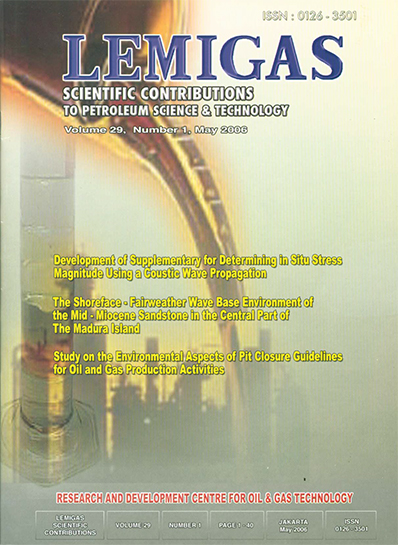POSSIBILITY TO ESTIMATE BULK PERMEABILITY FROM SEISMIC DATA
DOI:
https://doi.org/10.29017/SCOG.29.1.1022Keywords:
Possibility, Permeability, Seismic DataAbstract
Permeability is one of the most important reservoir parameter which determines the reserves. Unlike the porosity which is considered to be the static property of oil and gas reservoir, permeability is the dynamic property. It reflects the ability of reservoir rock to transmit fluid (oil gas or water). The reservoir rock is located deep below the subsurface, so that the measurement of the permeability is usually carried out from the cores. So far there is no well logging tool which measures the rock permeability directly. Physically, there is no direct relationship between porosity and permeability, the estimation of permeability from the cross-plot between porosity and permeability is just a rough estimate, but it is usually accepted in practical application. Apart from cross- correlation method, there is now exist a sophisticated approach to estimate permeability based on well log data using artificial neural network. There now exist a method which is widely accepted to estimate the porosity of the subsurface layer using seismic method. This method exploits the relationship between porosity and acoustic impedance of the sub- surface layer. And since acoustic impedance can be derived from the seismic amplitudes, it means that the rock porosity can be estimated from seismic data. A new question can be exposed as follows : "Is there any seismic wave parameter or quantity which is theoretically can be releted to permability ?" (so that the estimation of reservoir permeability can be estimated from seimic data). This paper tries to propose an idea to use a specific seismic wave parameter whis is theoretically can be related to the permeability of a reservoir rock, with a hope that more detail research can be pointed to that direction. This idea is supported by qualitative analysis and some theoretical findingsReferences
Akbar, N., Dvorkin, J. and Nur, A., 1993, Relating P-wave attenuation to permeability,
Geophysics, 5, No.1 (Jan), 20-29.
Biot, M.A., 1956, Theory of propagation of elastic waves in fluid saturated porous rock, J.
Acoust. Soc. Am, 28, 168-191.
Gassmann, F., 1951, Ueber die Elastizitat Poroser Medien, Viereljahrschrift der
Naturforchenden Gesellschaft in Zurich, V.96, 1-23.
Geertsma, J. and Smit, D.C., 1961, Some aspect of elastic wave propagation in fluid
saturated porous solid, Geophysics,26, 169-181.
Kjartannson, E., 1979, Constant Q-wave propagation and attenuation, J. Geophys. Res,
,4737- 4748.
Ricker, N., 1977, Transient Waves in Visco Elastic Media, Elsevier, Amsterdam.
Spencer,T.W.,Sonnad, J.R. and Buttler, T.M., 1982, Seismic Q-stratigraphy or dissipation,
Geophysics, 47, 16-24.
Sismanto, 2003, Estimasi permeabilitas reservoir batu pasir tebal dan homogen dengan
menggunakan analisis atenuasi inelastic data seismic,disertasi doctor, Teknik Geofisika
ITB, Bandung.
Turgut, A., and Yamamoto, T., 1988, Synthetic seismogram for marine sediments and
determination of porosity and permeability, Geophysics, 53, 1056-1067.
Whitten, D.G.A. and Brooks, J.R.V., 1979, Dictionary of Geology Books, Canada.
Yamamoto, T., 1983, Propagator Matrix for Continuosly Layered Porous Seas, B.S.S.A.,
, 1599-1620
Downloads
Issue
Section
License
Copyright (c) 1970 SCIENTIFIC CONTRIBUTIONS OIL AND GAS (SCOG)

This work is licensed under a Creative Commons Attribution 4.0 International License.
Authors are free to Share — copy and redistribute the material in any medium or format for any purpose, even commercially Adapt — remix, transform, and build upon the material for any purpose, even commercially.
The licensor cannot revoke these freedoms as long as you follow the license terms, under the following terms Attribution — You must give appropriate credit , provide a link to the license, and indicate if changes were made . You may do so in any reasonable manner, but not in any way that suggests the licensor endorses you or your use.
No additional restrictions — You may not apply legal terms or technological measures that legally restrict others from doing anything the license permits.














